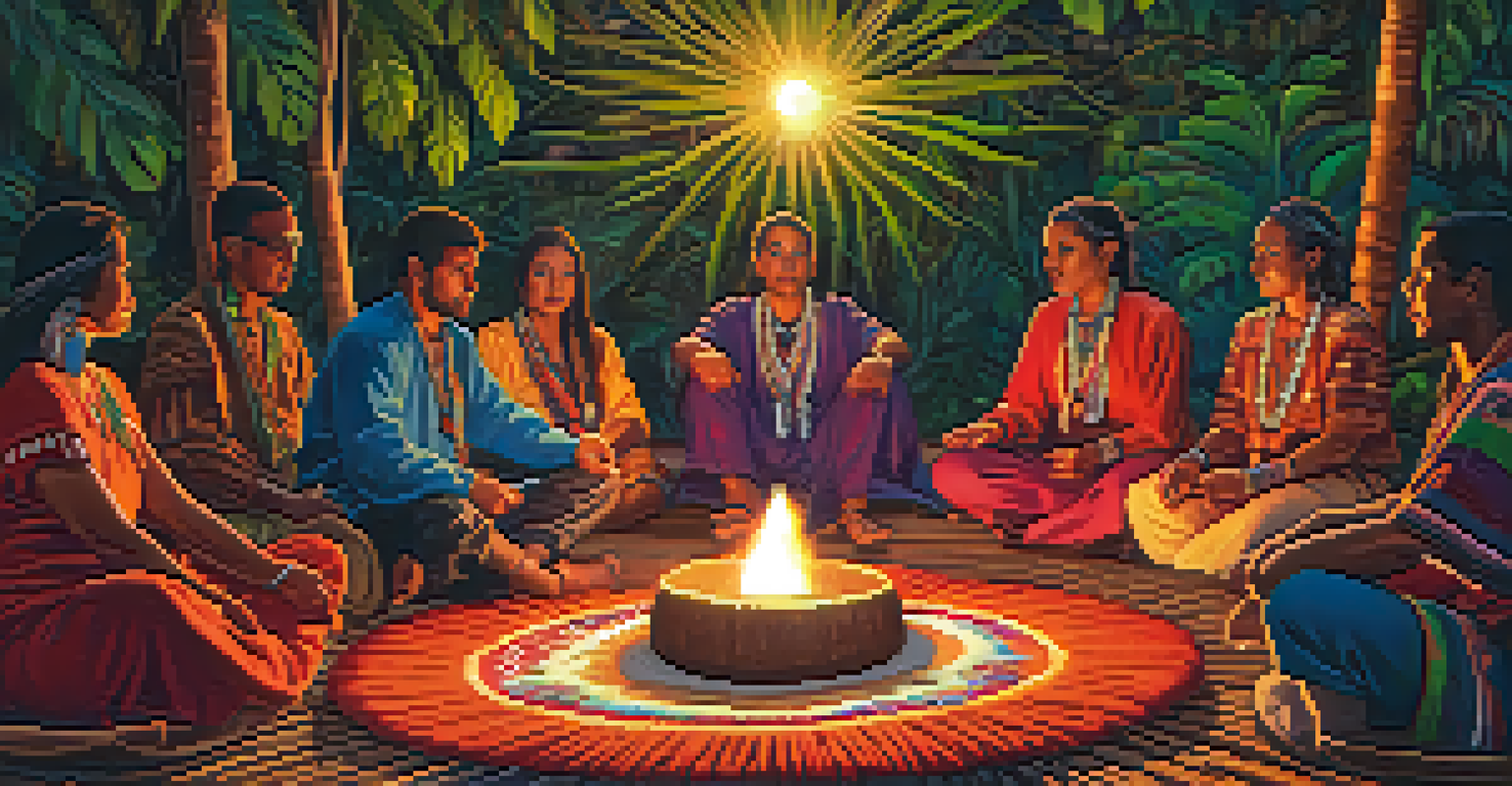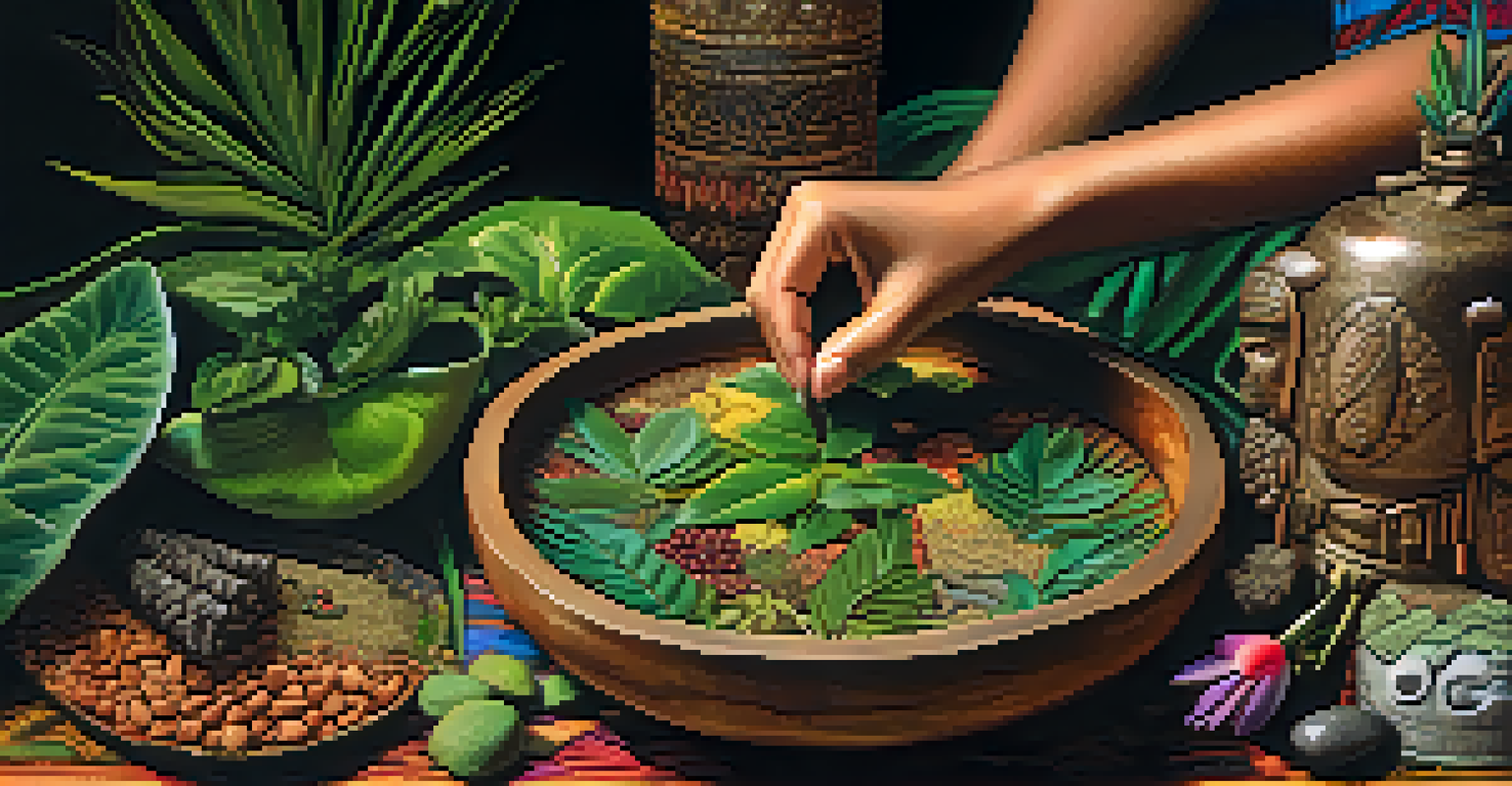The Intersection of Gender and Spirituality in Ayahuasca

Understanding Ayahuasca: A Brief Overview
Ayahuasca is a powerful brew made from the Banisteriopsis caapi vine and other plants, traditionally used in Amazonian shamanic practices. It induces altered states of consciousness, often leading to profound spiritual experiences. Participants typically seek guidance, healing, or personal insight through these ceremonies, which are deeply rooted in cultural traditions.
Ayahuasca is a tool for personal transformation, helping individuals confront their inner challenges and embrace their true selves.
The brew’s psychoactive properties come primarily from DMT (dimethyltryptamine), which can lead to vivid visions and emotional releases. While it’s gaining popularity worldwide, understanding the cultural context of its use is essential for a respectful approach. This context includes the roles that gender plays in both the preparation and experience of ayahuasca ceremonies.
In many indigenous cultures, gender roles influence who can serve as shamans or facilitators, shaping the dynamics of the ceremonies. Recognizing these gendered experiences can enhance our understanding of ayahuasca's spiritual significance.
Gender Roles in Ayahuasca Traditions
In traditional ayahuasca ceremonies, gender roles often dictate who participates and how they engage with the process. Male shamans, or curanderos, have historically led many ceremonies, while women, or curanderas, are increasingly gaining visibility. This shift reflects broader societal changes regarding gender equality and empowerment.

The roles of men and women in these ceremonies can impact the spiritual journey of participants. For instance, the presence of female shamans might foster a more nurturing environment, which can be particularly significant for female participants seeking healing. Conversely, male-led ceremonies may emphasize strength and authority, appealing to different spiritual needs.
Ayahuasca's Cultural Significance
Understanding the cultural context of ayahuasca, including the roles of gender in ceremonies, is essential for a respectful and meaningful experience.
Understanding these dynamics helps us appreciate the rich tapestry of experiences that ayahuasca offers, showcasing how gender influences the spiritual landscape. Each ceremony is unique, shaped by the gender of the shaman and the cultural beliefs surrounding them.
Women's Spiritual Empowerment Through Ayahuasca
Ayahuasca ceremonies provide a unique space for women to explore their spirituality and reclaim their power. As more women assume roles as shamans, they create environments where feminine wisdom and healing practices are celebrated. This has led to an increase in female participation in ceremonies, as many feel more comfortable in spaces led by women.
The most profound journeys often happen within the community, where shared experiences can lead to collective healing.
The experience of ayahuasca can catalyze personal transformation, leading many women to confront societal expectations and personal traumas. The emotional and spiritual insights gained during ceremonies can empower them to take charge of their lives. This empowerment often translates into broader social change, encouraging women to challenge traditional gender roles.
Sharing stories of healing and growth fosters community among women, reinforcing the idea that spiritual journeys are not solitary but collective. This interconnectedness is a vital aspect of the ayahuasca experience, highlighting the importance of female voices in spiritual practices.
Men's Spiritual Journeys with Ayahuasca
For many men, ayahuasca serves as a pathway to explore vulnerability and emotional depth in a culturally masculine framework. Traditionally, men may feel pressured to embody strength and stoicism, making the introspective nature of ayahuasca both challenging and liberating. This brew can facilitate a profound connection to their emotions, often leading to personal breakthroughs.
The journey through ayahuasca can encourage men to reconsider their roles within both their families and society. By confronting insecurities, fears, and past traumas, men can foster healthier relationships with themselves and others. This transformation is essential for cultivating a more balanced and compassionate masculinity.
Gender Dynamics in Ceremonies
The evolving roles of men and women within ayahuasca ceremonies highlight important shifts towards gender equality and empowerment in spiritual practices.
Moreover, sharing experiences in male-dominated spaces can promote conversations around vulnerability, encouraging others to embrace their emotional journeys. This shift challenges stereotypes and fosters a culture of support and understanding among men.
The Role of Community in Ayahuasca Ceremonies
Community plays a crucial role in the ayahuasca experience, influencing both the spiritual and emotional journeys of participants. Whether through shared stories, collective rituals, or mutual support, the presence of others can enhance the healing process. This sense of belonging is particularly significant for individuals exploring their gender identities within the spiritual context.
In many ceremonies, participants come together to create a safe space for vulnerability and openness. This communal aspect allows individuals to witness and support each other's journeys, breaking down barriers related to gender. It reinforces the idea that spiritual growth is enhanced through connections with others.
As these communities grow and evolve, they often reflect broader societal changes, challenging stereotypes and promoting inclusivity. The bonds formed in these ceremonies can lead to lasting friendships and support systems that extend beyond the ayahuasca experience.
Intersectionality: Gender, Culture, and Spirituality
The intersection of gender and spirituality in ayahuasca practices highlights the importance of understanding individual experiences within broader cultural contexts. Intersectionality considers how different aspects of identity—such as race, class, and gender—interact to shape unique experiences. In ayahuasca ceremonies, this means recognizing that each participant's journey is influenced by their multifaceted identity.
For instance, indigenous women participating in ayahuasca ceremonies may face different challenges and opportunities compared to women from urban backgrounds. Similarly, men from various cultures may approach their journeys with distinct expectations and experiences. Acknowledging these differences allows for a deeper appreciation of the spiritual landscape and the diverse voices within it.
Community's Role in Healing
The communal aspect of ayahuasca ceremonies fosters connection and support, enhancing the spiritual and emotional journeys of participants.
By fostering an inclusive dialogue that considers intersectionality, we can better understand how spirituality is experienced and expressed across genders. This approach encourages respect and empathy, paving the way for more nuanced conversations about spirituality and personal growth.
Conclusion: The Future of Gender and Ayahuasca
As ayahuasca continues to gain popularity outside of its traditional settings, the conversation around gender dynamics will undoubtedly evolve. Increasingly, women are stepping into leadership roles, reshaping the narrative around spirituality and healing. This shift is crucial for creating a more equitable and inclusive environment in ayahuasca practices.
The future of ayahuasca spirituality lies in recognizing and honoring the diverse experiences of all participants. By embracing the unique contributions of different genders, we can cultivate a richer understanding of the brew’s potential for healing and transformation. This collective journey encourages a more holistic approach to spirituality.

Ultimately, the intersection of gender and spirituality in ayahuasca invites us to reflect on our own beliefs and practices. As we navigate these complex dynamics, we can foster a deeper sense of connection and understanding, paving the way for more inclusive spiritual experiences.